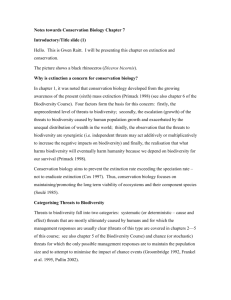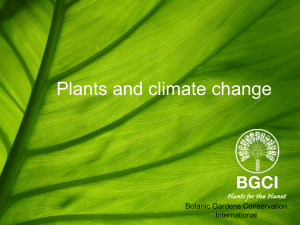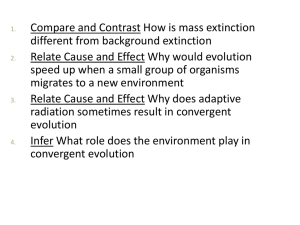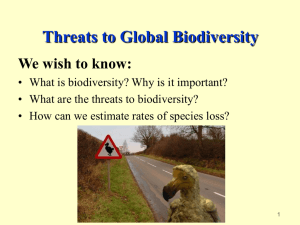NotesChapter7
advertisement
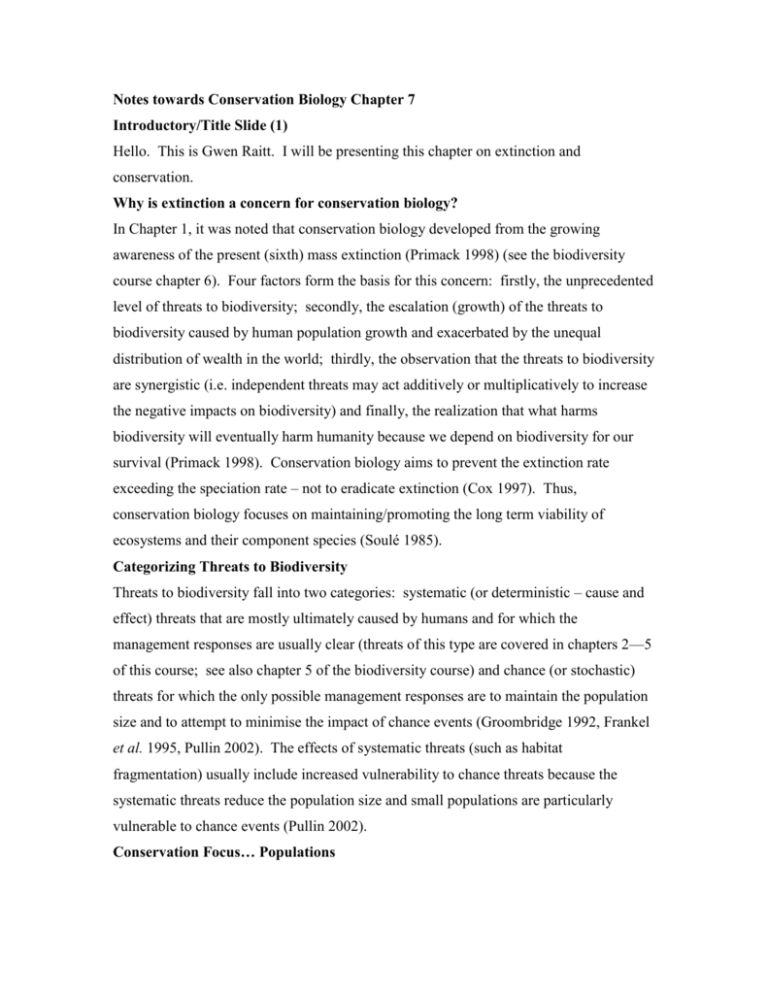
Notes towards Conservation Biology Chapter 7 Introductory/Title Slide (1) Hello. This is Gwen Raitt. I will be presenting this chapter on extinction and conservation. Why is extinction a concern for conservation biology? In Chapter 1, it was noted that conservation biology developed from the growing awareness of the present (sixth) mass extinction (Primack 1998) (see the biodiversity course chapter 6). Four factors form the basis for this concern: firstly, the unprecedented level of threats to biodiversity; secondly, the escalation (growth) of the threats to biodiversity caused by human population growth and exacerbated by the unequal distribution of wealth in the world; thirdly, the observation that the threats to biodiversity are synergistic (i.e. independent threats may act additively or multiplicatively to increase the negative impacts on biodiversity) and finally, the realization that what harms biodiversity will eventually harm humanity because we depend on biodiversity for our survival (Primack 1998). Conservation biology aims to prevent the extinction rate exceeding the speciation rate – not to eradicate extinction (Cox 1997). Thus, conservation biology focuses on maintaining/promoting the long term viability of ecosystems and their component species (Soulé 1985). Categorizing Threats to Biodiversity Threats to biodiversity fall into two categories: systematic (or deterministic – cause and effect) threats that are mostly ultimately caused by humans and for which the management responses are usually clear (threats of this type are covered in chapters 2—5 of this course; see also chapter 5 of the biodiversity course) and chance (or stochastic) threats for which the only possible management responses are to maintain the population size and to attempt to minimise the impact of chance events (Groombridge 1992, Frankel et al. 1995, Pullin 2002). The effects of systematic threats (such as habitat fragmentation) usually include increased vulnerability to chance threats because the systematic threats reduce the population size and small populations are particularly vulnerable to chance events (Pullin 2002). Conservation Focus… Populations Extinction tends to bring specific species (e.g. the dodo - Raphus cucullatus) or other taxonomic units (e.g. the dinosaurs – the picture shows a Triceratops skeleton) to mind (Caughley & Gunn 1996). While conservation of all levels of biodiversity is important (Frankel et al. 1995), the species is a pragmatic choice of conservation unit because it is (relatively) easily identifiable and therefore quantifiable (Caughley & Gunn 1996, Pullin 2002) but the threats that cause species extinction act at the population/metapopulation level (Barbault & Sastrapradja 1995) and populations share an evolutionary future therefore, the population/metapopulation is the actual unit of management for species conservation (Frankel et al. 1995, Caughley & Gunn 1996). Populations are also the means of conserving genetic diversity in the form of allele diversity (Frankel et al. 1995). Reducing the probability of chance extinctions for small populations by minimizing the impact of chance events is an important part of conservation – both in situ (because reserves exist as islands in a human landscape (Knight 1999)) and ex situ (Frankel et al. 1995, Pullin 2002). It is however, also most important to remember not to focus so intensively on small population size that no action is taken to reduce the factors that caused the original population decline – the deterministic threats (Caughley & Gunn 1996, Pullin 2002). Populations A population is a group of interacting individuals of a given species living in a specific geographic area at one time (Miller 2002, Wikipedia Contributors 2006a). Population size is affected by birth, death and migration (Miller 2002). Births and immigrations add to the population size while deaths and emigrations reduce the population size (Cox 1997, Miller 2002). The amount of migration depends on the degree of population isolation (Groombridge 1992). Population size and survival depend on: the availability of resources such as food, shelter, clean water and clean air (Barbault & Sastrapradja 1995, Cox 1997, Miller 2002), the amount of suitable habitat available (Barbault & Sastrapradja 1995), the amount of predation/parasitism (Barbault & Sastrapradja 1995, Dobson 1996), the prevalence of disease and finally social interactions (Barbault & Sastrapradja 1995). The picture shows Cape Gannet (Morus capensis) behaviour. Mechanisms of Chance Extinction in Single Populations Population extinction is certain if, in the long term, the mortality rate is higher than the birth rate (Barbault & Sastrapradja 1995) in the absence of migration. If migration is present, extinction is certain if, in the long term, the combined death and emigration rates exceed the combined birth and immigration rates (Miller 2002). Extinction mechanisms act by raising the mortality rate, lowering the birth rate (Barbault & Sastrapradja 1995, Dobson 1996), lowering the migration rate or any combination of the three. The mechanisms may be grouped into three categories for single populations (Barbault & Sastrapradja 1995). Firstly, chance (stochastic) variation occurs in birth and death rates, affecting the population size. This is known as demographic uncertainty (or stochasticity). Very small populations are vulnerable to extinction caused by demographic uncertainty. Decreasing the population density below a critical threshold results in decreased social interaction between individuals (termed Allee effects) and hence a decreased birth rate and an increased mortality rate (Barbault & Sastrapradja 1995, Frankel et al. 1995, Caughley & Gunn 1996, Dobson 1996, Primack 1998, Pullin 2002). Secondly, environmental uncertainty reflects the effects of chance changes in the environment in which the populations occurs (Groombridge 1992, Barbault & Sastrapradja 1995, Frankel et al. 1995, Caughley & Gunn 1996, Dobson 1996, Primack 1998, Pullin 2002). This includes such unpredictable events as ‘natural’ catastrophes (Begon et al. 1996, Caughley & Gunn 1996, Menges 2000) which may be aggravated or caused by human behaviour (Brown 2001, Pauchard et al. 2006). The picture is of a flood in Mozambique – the houses conveniently show that the water is above its normal level. Finally, loss of genetic diversity (biodiversity loss) affects the chances of population extinction (Groombridge 1992, Barbault & Sastrapradja 1995). A potential impact of loss of genetic diversity is the reduced fecundity and viability caused either by inbreeding depression (which may occur in the offspring if closely related individuals mate) or by outbreeding depression (caused by individuals from divergent populations mating with the result that local adaptations to the environment are lost) (Barbault & Sastrapradja 1995, Frankel et al. 1995). Another impact is the reduction of genetic variability in small populations due to genetic drift (changes in allele frequencies) (Barbault & Sastrapradja 1995, Frankel et al. 1995). Mechanisms may interact, compounding the effect on the population (Groombridge 1992). Population size is critical to survival (Barbault & Sastrapradja 1995). Metapopulations A metapopulation is made up of a number of spatially separated, extinction-prone local populations (or subpopulations) that are linked by migration (Groombridge 1992, Barbault & Sastrapradja 1995, Wikipedia Contributors 2006b). It may be described as a “population of populations” with two levels of population dynamics: within local populations and between local populations (Begon et al. 1996, Primack 1998). Plants tend to occur in metapopulations (Frankel et al. 1995). Other than the classical metapopulation, the following types are recognized: mainland-island metapopulations have at least one large stable population that is not likely to become extinct which provides immigrants to other habitat fragments that may be more extinction prone (Barbault & Sastrapradja 1995, Caughley & Gunn 1996, Pullin 2002), source-sink metapopulations occur if some populations have a growth rate that exceeds the capacity of the habitat forcing emigration to other populations which have a higher mortality rate than birth rate (Groombridge 1992, Barbault & Sastrapradja 1995, Begon et al. 1996, Caughley & Gunn 1996, Primack 1998) and non-equilibrium metapopulations are the result of recent habitat fragmentation and may not survive as no equilibrium exists between colonizations and extinctions and the development of such an equilibrium is not guaranteed (Barbault & Sastrapradja 1995). Metapopulation survival depends on: local population survival (see slide on populations for factors required for local population survival), unoccupied suitable habitat at suitable distances (i.e. within migration distance of occupied habitats) and sufficient migration for colonization of unoccupied habitat to occur (Barbault & Sastrapradja 1995). The picture shows a Jackass Penguin (Spheniscus demersus) subpopulation (colony). Mechanisms of Chance Extinction in Metapopulations Extinction of a metapopulation is certain if the local population extinction rate exceeds the rate at which new populations are established (Barbault & Sastrapradja 1995, Pullin 2002). Local population extinction mechanisms are those of single populations (Barbault & Sastrapradja 1995). The mechanisms acting at the metapopulation level may be grouped into two categories. Colonization-extinction uncertainty is analogous to demographic uncertainty for single populations. This is a threat if the network containing the metapopulation only has a few habitat patches and the local populations have a high risk of extinction (Barbault & Sastrapradja 1995). Regional uncertainty is equivalent to environmental uncertainty for single populations. The risk of extinction by regional uncertainty decreases as the distance between subpopulations increases (Barbault & Sastrapradja 1995). The picture shows a diagram of a mountain (or bighorn) sheep (Ovis canadensis) metapopulation. Scientific Conservation Action in Response to Population Decline In this course, we have considered various forms of systematic (chapters 2—5) and chance threats (this chapter) to species persistence. So, how does conservation deal with these threats? Conservation biologists have to deal with those species that have already been reduced to remnants and attempt to prevent more species from reaching this remnant status. On the premise that prevention is better (and possibly cheaper) than cure, a scientific approach to identifying and mitigating (if possible reversing) a population decline will be presented first. The first step is understanding that a sustained population decline signals a conservation problem (Caughley & Gunn 1996). This means that longer term population declines need to be identified and confirmed. This is particularly important because acting after the population is severely reduced makes identifying the cause of the reduction difficult and the species may be lost before action can be taken (Caughley & Gunn 1996) as happened with the large blue butterfly (Maculinea arion) in Britain (Elmes & Thomas 1992, Caughley & Gunn 1996). This relies where possible on monitoring either population size or the range of the species. In the absence of enough monitoring data to meet the requirements of statistics to provide an estimate of population size, the knowledge of local people is the best available information. This knowledge should never be ignored (Caughley & Gunn 1996). The next step is to develop a basic understanding of the species ecology (or ‘life history’ - i.e. such things as habitat and food preferences – not at this stage, detailed demographic studies). This knowledge is necessary for diagnosing the cause of the population decline and for efforts to promote the recovery of the species (Caughley & Gunn 1996). The large blue butterfly (Maculinea arion – pictured) became extinct in Britain because its specialist relationship with its ant host (Myrmica sabuleti) was not understood (Elmes & Thomas 1992). Taking the ecological knowledge into consideration, all possible causes of the decline should be listed. Thereafter, the level of each possible cause should be obtained in relation to the present distribution of the species and its past distribution. Should the results indicate that a particular cause is likely, a hypothesis is created. This hypothesis must be tested by experimentation to be sure that the possible cause is actually causing the decline. This is necessary for effective conservation action to ‘treat’ the problem and potentially saves time and money that would be spent on useless action. It is possible that a combination of causes will be identified (Caughley & Gunn 1996). Once the cause(s) of a decline is(are) identified, possible actions to remove and neutralize it(them) should be tested for effectiveness by experimentation (not only by modeling). Plans for action need to include projections of population trends and identification of potential measures to cope should the population recover to point where it exceeds its carrying capacity. All plans for action must involve monitoring (Caughley & Gunn 1996). Monitoring The status of a species can only be determined by monitoring it (Primack 1998). Monitoring is also necessary to judge the effectiveness of conservation actions (Caughley & Gunn 1996). Monitoring may take three forms. Inventories are counts of the number of individuals in the population or the number of species in a community (Primack 1998). Surveys are estimates of population size based on sampling. They are used where populations are large or cover an extensive range. Surveys are methodical and repeatable though very time consuming. They are especially useful where populations have stages in the life cycle that are difficult to identify or locate (Primack 1998). Game counts, a form of survey, may be done from the air as shown in the pictures. Demographic studies follow known/‘marked’ individuals through their life cycle. Individuals of all ages and sizes must be included in such studies. These studies provide the most comprehensive information and may suggest management actions to ensure persistence. The down side is that such studies are time consuming and expensive since repeated visits are required (Primack 1998). The effectiveness of monitoring depends on the scale at which it is carried out (Pullin 2002). The information from monitoring may be used for population viability analysis. Population Viability Analysis Population viability analysis (PVA) is a risk assessment for populations or species based on empirical data that estimates the probability (risk) of extinction for a population of the specific species for a selected time interval (e.g. 5% extinction probability (= 95% probability of survival) for 100 years) (Frankel et al. 1995, Caughley & Gunn 1996, Cox 1997, Menges 2000, Wikipedia Contributors 2006c). Three approaches to PVA exist: pattern analysis of long term studies, subjective assessment using decision analysis based on expert knowledge and mathematical and/or statistical modeling (Begon et al. 1996, Cox 1997). The most commonly discussed approach is modeling (Caughley & Gunn 1996, Primack 1998, Menges 2000, Chapman et al. 2001, Coulson et al. 2001, Pullin 2002). All the approaches require information. The choice of approach depends on the quality and quantity of data available. Long term data sets are not usually available for endangered species (Coulson et al. 2001, Wikipedia Contributors 2006c) which reduces the reliability/accuracy of models (Menges 2000, Coulson et al. 2001) and rules out pattern analysis. The picture shows bighorn sheep (Ovis canadensis) which have been studied for about 70 years – an example of a long term data set (Primack 1998). Population Viability Analysis – Information Needed All the approaches to PVAs require information (Begon et al. 1996). The mathematical and statistical modeling used in population viability analysis requires lots of detailed ecological information on the growth and vital rates of the selected species to have any degree of accuracy (Primack 1998, Coulson et al. 2001, Pullin 2002, Wikipedia Contributors 2006c). If one is to gain an accurate extinction probability for t years from a model, one needs an estimated 5t – 10t years of data (Wikipedia Contributors 2006c). For most threatened species such data is unavailable so decisions have to be taken without adequate information (Primack 1998, Coulson et al. 2001, Pullin 2002, Wikipedia Contributors 2006c). For each species, information is required on the: morphology (for identification among other things), environment (habitat, area, variability and human impact), distribution (e.g. within its habitat, geographic, etc.), biotic interactions (e.g. competition and predation), behaviour (e.g. reproductive), population demography (e.g. age distribution and size over time), genetics (e.g. the degree of genetic control of morphological and physiological traits) and physiology (e.g. physical requirements) (Primack 1998). This information may be compiled from: published literature (such as the journal ‘Conservation Biology’), unpublished literature, fieldwork (Primack 1998), the knowledge of experts (Begon et al. 1996) and the knowledge of locals (which should be used with caution but not ignored) (Caughley & Gunn 1996). The internet is increasingly important for accessing literature (Primack 1998). Uses of Population Viability Analysis PVA may be used to: estimate the extinction probability for a population (Caughley & Gunn 1996, Coulson et al. 2001, Pullin 2002, Wikipedia Contributors 2006c); determine the minimum viable population (Begon et al. 1996, Cox 1997); determine minimum reserve size (Caughley & Gunn 1996) – the area needed to support an MVP; predict future population size (Coulson et al. 2001); determine the IUCN status of the species (Chapman et al. 2001); show the importance of recovery efforts (Wikipedia Contributors 2006c); identify key stages of the life cycle on which to focus recovery efforts (Wikipedia Contributors 2006c); compare proposed management options and develop action plans for recovery efforts (Primack 1998, Coulson et al. 2001, Pullin 2002, Wikipedia Contributors 2006c) (this use of comparing management actions and planning recovery efforts is potentially dangerous because PVAs consider the population size without identifying the cause of a decline in size (Caughley & Gunn 1996)); evaluate existing recovery efforts (Wikipedia Contributors 2006c) (in conjunction with monitoring) and explore and evaluate the potential impacts of habitat loss, habitat fragmentation and habitat disturbance/degradation or the consequences of various assumptions for small populations (Caughley & Gunn 1996, Primack 1998, Coulson et al. 2001, Wikipedia Contributors 2006c). One of the earliest (perhaps the first) PVAs done on plants was done by Menges in 1990 on Furbish Lousewort (Pedicularis furbishiae) – pictured. It showed that metapopulation dynamics were important in the survival of Furbish Lousewort (Frankel et al. 1995). Minimum Viable Population The minimum viable population (MVP) may be defined as the lowest number of individuals needed to ensure that a population has a selected probability of survival for a set time period without significant loss of evolutionary adaptability (Frankel et al. 1995, Cox 1997), sometimes stated as the threshold below which a population will decline to extinction (Caughley & Gunn 1996, Pullin 2002). Shaffer (not the first to define the concept) selected a 99% probability of survival for 1 000 years (Frankel et al. 1995, Primack 1998, Pullin 2002). While desirable, these criteria are unrealistic if one considers the accuracy of calculations for such long term predictions (Frankel et al. 1995, Pullin 2002). Few populations of plants would meet these criteria (Frankel et al. 1995). A selection of parameters, that may be achievable, is a 95% survival probability for a 100 years (Groombridge 1992, Pullin 2002). An MVP for a species is an estimate and therefore not a unique number (Frankel et al. 1995, Wikipedia Contributors 2006d). No MVP is applicable to all species (Groombridge 1992, Barbault & Sastrapradja 1995). Three further points should be noted concerning an MVP: it is applicable to a particular habitat in an ecological context; if it includes genetic parameters, it is usually an estimate of the effective population size not the actual population size needed and the level (subpopulation/population, metapopulation or species) at which the MVP is applied must be specified (Frankel et al. 1995). It may be beneficial to consider an MVP in terms of the area needed to support it (the minimum dynamic area (MDA)) (Frankel et al. 1995, Primack 1998). The picture shows grizzly bears (Ursus arctos horribilis). Various people have estimated the MVP and MDA for grizzly bears (Primack 1998). Effective Population Size The effective population size (Ne) equals that of an ideal population that is genetically influenced by random genetic drift in the same measure as the actual population (N). In an ideal population, mating is random and the variation in individual progeny (offspring) numbers is random. For animals, a 1:1 sex ratio exists and for plants, all individuals reproduce sexually and are diploid and bisexual, simultaneously producing female and male gametes with a self-fertilization rate of Ne-1 (Frankel et al. 1995, Cox 1997). More simply phrased it is the average number of individuals breeding successfully with the assumption that gene contribution to the next generation is equal (Fiedler & Jain 1992, Pullin 2002). Effective population size is frequently less than actual population size because all nonreproductive individuals (because of immaturity, age or lack of reproductive success) are excluded (Primack 1998, Pullin 2002, Wikipedia Contributors 2006e). The picture shows an Emperor Penguin (Aptenodytes forsteri) breeding colony with a chick and its parents in the foreground. The effective population size for the Emperor Penguin equals the number of adults in the colony when both parents are present. Non-breeding or unsuccessful adults are not present in the colony but form part of the actual population size as do the chicks in the colony. Factors Affecting Effective Population Size The effective population size (Ne) is affected by: unequal sex ratios including those produced by social systems such as polygamy or, in plants, self incompatibility (Frankel et al. 1995, Begon et al. 1996, Caughley & Gunn 1996, Dobson 1996, Cox 1997, Primack 1998, Pullin 2002); variation in reproductive output (the number of progeny produced) of both male and female individuals because this leads to disproportionate representation of the genes of a few individuals (of both sexes) in the next generation (Frankel et al. 1995, Begon et al. 1996, Caughley & Gunn 1996, Dobson 1996, Primack 1998, Pullin 2002); population fluctuations because Ne is strongly influenced by the smallest population size (termed a population bottleneck) experienced by the population (Frankel et al. 1995, Begon et al. 1996, Caughley & Gunn 1996, Primack 1998, Pullin 2002); whether or not generations overlap because overlapping generations are less affected by genetic drift (Frankel et al. 1995, Caughley & Gunn 1996, Cox 1997); age structure because fecundity and mortality may be age-specific (Frankel et al. 1995); dispersal because migration reduces genetic drift (Caughley & Gunn 1996); the distribution of individuals (also termed neighbourhood size) because this affects which individuals are spatially capable of breeding with each other (Frankel et al. 1995, Caughley & Gunn 1996) and inbreeding (which is especially important in plants because some are self-pollinating), the occurrence of which reduces Ne (Frankel et al. 1995). The top picture shows the African Wild Dog (Lycaon pictus). Only the alpha female of a pack breeds (Wikipedia Contributors 2006f) so the sex ratio is skew as a result of the social system. The bottom picture shows pine tree pollen for wind dispersal. Population Viability Analysis Using Modeling The use of models for PVAs requires caution and common sense. A slight change in the parameters combined with a change in the assumptions the model is based on may give very different results (Primack 1998). The validity of a PVA depends on the model’s quality and structure (Wikipedia Contributors 2006c). Models may not include enough ecology to be reliable (Caughley & Gunn 1996, Watson et al. 2005) as was found to be the case for the model used to study Cape mountain zebra (Equus zebra zebra - pictured) in the Gamka Mountain Nature Reserve, South Africa (Watson et al. 2005) and was demonstrated for two models attempting to predict the extinction probability for the Soay sheep (Ovis aries) (Chapman et al. 2001). Two conditions need to be met for a PVA to be reasonably accurate: the data must be of adequate quality and the future vital rates for the population need to be similar to the present rates used in the model. The latter condition can usually not be guaranteed (Coulson et al. 2001). Computer programs do exactly what they have been told to do within the constraints of the model used. The user must have a basic understanding of ecology and the ecology of the specific species to know when different models are adequate (Caughley & Gunn 1996). The process of selecting a model needs to consider whether the model assumptions are applicable in the population to be studied and whether the data are adequate to provide reliable inputs into the model. The form of density dependence needs to be taken into account in choosing a model. It needs to reflect the mechanisms of population regulation or the results will be unrealistic (Chapman et al. 2001). PVA software packages include INMAT and VORTEX. VORTEX is more flexible than INMAT (Chapman et al. 2001). Scientific testing of models is necessary to determine reliability (Caughley & Gunn 1996). The use of PVAs does not replace monitoring (Primack 1998, Pullin 2002). PVAs are used on threatened species or species suspected of being under threat, but what causes suspicion that a species may be vulnerable to extinction? Vulnerability to Extinction While conservation priority is based on the level of threat of extinction that a species faces (Pullin 2002, see also chapter 6 of this course), there are some life history traits that can be used as a guide to the sensitivity of species to habitat fragmentation and human disturbance (Groombridge 1992) and therefore also as a guide to which species should be monitored (Caughley & Gunn 1996). A single species may have several of these traits because these traits are not independent (Groombridge 1992, Primack 1998). Several of the categories in the following slides may include common species. The passenger pigeon was abundant and widespread prior to its extinction (Leakey & Lewin 1995) – see chapter 3 of this course. Abundant species are not adapted to cope with small population sizes and are thus vulnerable if reduced to small populations (pers. comm. Dr R.S. Knight 2006). The following slides give a brief overview of the identified categories of traits that make species vulnerable to extinction. The picture shows a drawing of Gladiolus carinatus (the blou-afrikaner or sandpypie). Most years, many plants are pulled up by people collecting the flowers for sale (pers. obs.). Vulnerability to Extinction 2 The following categories of species are vulnerable to extinction. Species that only occur in threatened habitat types (Barbault & Sastrapradja 1995) (e.g. tropical forest species) because no species is capable of surviving the sudden and total removal of its habitat and if the habitat is fragmented, the carrying capacity (the largest sustainable population size) of the habitat fragments is determined by the area of the habitat fragment (Pullin 2002). Species that are economically valuable to humans are threatened by overexploitation resulting from both legal and illegal harvesting (Cox 1997, Primack 1998) – see chapter 3 of this course. Species that do not have any/much experience of disturbance are unable to tolerate major disturbances and may not be readily able to adapt to disturbance (Barbault & Sastrapradja 1995, Primack 1998). Species that have evolved in isolation within a limited community without human contact are at risk because of their endemic status and because isolation may have made them unable to cope with competition and predation from introduced species (Barbault & Sastrapradja 1995, Dobson 1996, Cox 1997, Primack 1998) – see the invasion biology course and chapter 4 of this course. Specialist species are vulnerable because of their dependence on a limited range of resources and conditions that may not endure after pollution (Groombridge 1992, Cox 1997, Primack 1998). Species that depend on unreliable resources are vulnerable (Barbault & Sastrapradja 1995) to disturbances that affect their required resources. Species requiring large home ranges are vulnerable to habitat changes (Primack 1998). Species that have declining populations are vulnerable if the cause of the decline is not recognized and corrected (Primack 1998). Declining populations that are not identified (see slide 9 on scientific conservation action in response to population decline) will eventually drop below the MVP and get caught in an extinction vortex (Primack 1998). Vulnerability to Extinction 3 - Rarity Three parameters are used to identify species abundance. They are geographical range, habitat specificity and population size. Combined they give eight categories (see Table 7.1) of which seven are considered rare (Begon et al. 1996, Primack 1998, Pullin 2002). All forms of rarity may come under threat and require conservation action (Begon et al. 1996). Table 7.1: All the possible combinations of the three factors (geographic range, habitat specificity and population size) influencing species abundance modified slightly from Pullin (2002). Geographic Range Habitat specificity Large population size, dominant somewhere Small population size, not dominant 1 Large Small Broad Narrow Broad Narrow Locally abundant in several habitats over large range1 Locally abundant in a specific habitat over a large range Always sparse in several habitats over a large range Always sparse in a specific habitat over a large range Locally abundant in several habitats but geographically restricted Always sparse in several habitats and geographically restricted Locally abundant in a specific habitat but geographically restricted Always sparse in a specific habitat and geographically restricted The only category that is not considered rare. Vulnerability to Extinction 4The following categories of species are vulnerable to extinction. Short-lived species (Groombridge 1992) have less chance of surviving long enough to adapt to disturbance than do longer lived species. Species with a low adult survival rate are potentially more vulnerable to extinction (Groombridge 1992). Species with low genetic variability (e.g. the cheetah (Acinonyx jubatus)) may be unable to adapt to changing conditions (Primack 1998). Species with a low intrinsic growth rate take a long time to recover from chance population reductions (Groombridge 1992). Species with very variable population size risk declining below the MVP (Groombridge 1992). Species that lack long distance dispersal mechanisms are unable to migrate in response to rapidly changing conditions to which there might not be time to adapt resulting inevitably in extinction (Groombridge 1992, Barbault & Sastrapradja 1995, Dobson 1996, Primack 1998). Species that form aggregations, either permanent or temporary (e.g. colonial nesting such as the cape gannets (Morus capensis)) are vulnerable to exploitation and potentially to the break down of the social structure if the population declines the threshold required for social interactions (Barbault & Sastrapradja 1995, Cox 1997, Primack 1998). Migratory species (e.g. greater striped swallows (Hirundo cucullata) – pictured right) depend on more than one habitat type over a large geographical area increasing the risks of habitat changes creating barriers to migration and the chances of exploitation (Barbault & Sastrapradja 1995, Dobson 1996, Cox 1997, Primack 1998). Large species (e.g. blue whales (Balaenoptera musculus), elephants (Loxodonta africana) and Coast Redwoods (Sequoia sempervirens)) are vulnerable to exploitation or eradication because of competition for resources (top carnivores) (Barbault & Sastrapradja 1995, Dobson 1996, Primack 1998). Species feeding at a high trophic level are not abundant and are vulnerable to any disruption of the food chain as well as to the increasing concentration of certain toxins as one moves up a food chain (Groombridge 1992, Barbault & Sastrapradja 1995, Dobson 1996, Cox 1997). Points to Ponder That which harms biodiversity will eventually harm humanity (Primack 1998). No population survives forever (Primack 1998). Population size is critical to survival time (Barbault & Sastrapradja 1995). Monitoring is critical to identifying threatened populations/species (Caughley & Gunn 1996). Population viability analysis is a conservation tool that needs to be used with caution (Caughley & Gunn 1996, Primack 1998). Identifying and mitigating/removing (if possible) the causes of population decline are as important as striving to protect the reduced population from stochastic events as the reduced population will not be able to increase substantially without the mitigation of the original causes of decline (Caughley & Gunn 1996). The above statement suggests that conservation biology needs to focus some efforts on reducing the ultimate cause of species population decline viz. human population expansion. Sharing information (including - but not limited to - via education) is central to achieving changes in human attitudes and behaviour. Last slide I hope that you found chapter 7 informative and that you will enjoy chapter 8.
